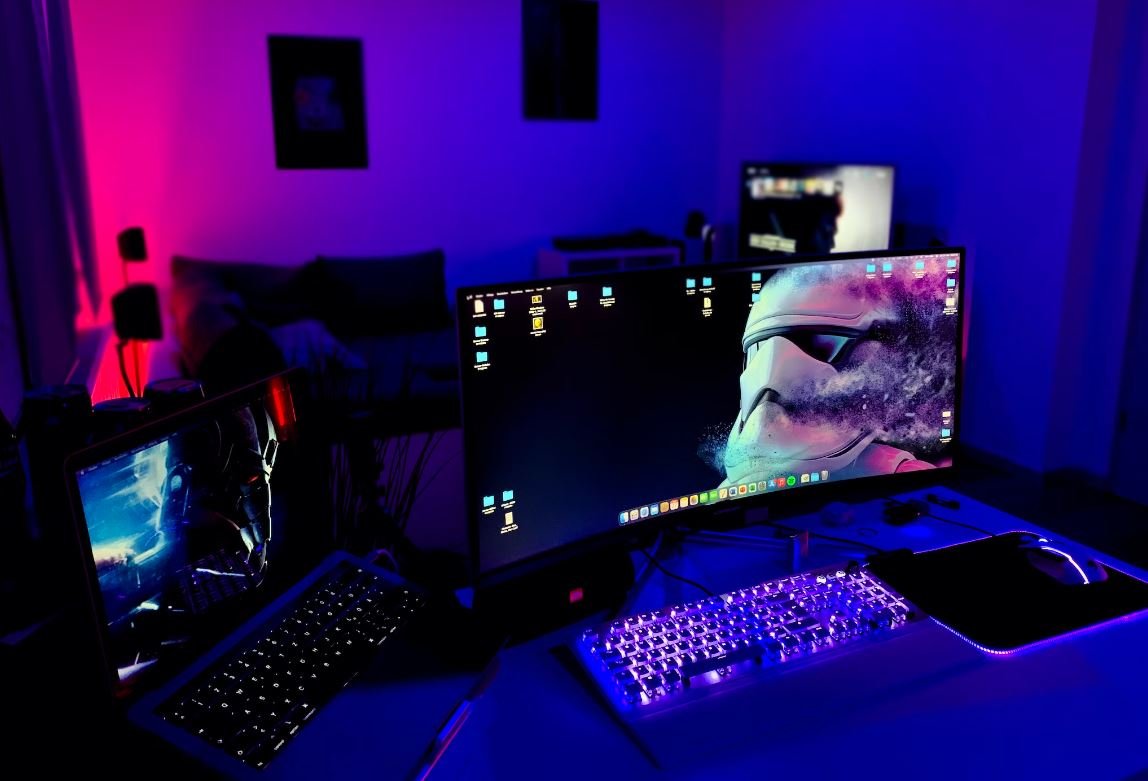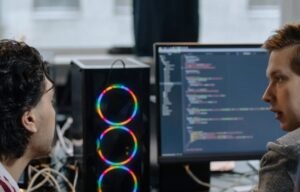Generative Autoencoder
A generative autoencoder is a type of artificial neural network that can learn to reconstruct and generate new data. It is composed of two main components: an encoder and a decoder. The encoder takes an input data point and encodes it into a lower-dimensional representation, while the decoder takes this representation and reconstructs the original data. This type of model is particularly useful in unsupervised learning tasks such as data compression, anomaly detection, and generative modeling.
Key Takeaways:
- A generative autoencoder is an artificial neural network used for data reconstruction and generation.
- The model consists of an encoder and a decoder, which learn to encode and decode data, respectively.
- Generative autoencoders are commonly used for unsupervised learning tasks like data compression and anomaly detection.
In a generative autoencoder, the encoder and decoder are typically implemented as neural networks. The encoder network takes an input data point, such as an image or a text document, and maps it to a lower-dimensional representation known as the latent space. This latent space representation is where the data is compressed or encoded. The decoder network then takes a point from the latent space and generates a reconstruction of the original data.
*Generative autoencoders are capable of learning meaningful representations of data without the need for explicit labels or supervision.
One interesting variant of a generative autoencoder is the variational autoencoder (VAE). In a VAE, the encoder does not directly output a single point in the latent space. Instead, it outputs a distribution over the latent space, represented by a mean and variance. This distribution allows the model to generate data that is more diverse and captures the inherent uncertainty of the underlying data distribution.
**Generative autoencoders can be used to generate new data samples by sampling from the latent space and passing the samples through the decoder. This makes them useful for tasks such as image generation, text generation, and even music composition.
Applications of Generative Autoencoders
Generative autoencoders have found applications in various domains. Here are some notable examples:
- Data Compression: Generative autoencoders can compress data into a lower-dimensional representation, effectively reducing storage and transmission requirements.
- Anomaly Detection: By learning the normal distribution of the data, generative autoencoders can detect anomalies or outliers in new and unseen data.
- Image Generation: Generative autoencoders can generate new images by sampling from the latent space and passing the samples through the decoder.
*Generative autoencoders have been successfully applied in various artistic domains, such as creating unique artwork and synthesizing new music.
Comparison of Generative Models
| Model | Type | Sample-based Generation |
|---|---|---|
| Generative Autoencoder | Unsupervised Learning | Yes |
| Generative Adversarial Networks (GANs) | Unsupervised Learning | Yes |
| Variational Autoencoders (VAEs) | Unsupervised Learning | Yes |
**Generative autoencoders, along with generative adversarial networks (GANs) and variational autoencoders (VAEs), are popular generative models in the field of deep learning. Each of these models has its own strengths and weaknesses, and their choice depends on the specific application and desired outcomes.
***Generative autoencoders, like other deep learning models, require significant amounts of training data to learn meaningful representations. However, with the advancement of techniques such as transfer learning and data augmentation, they can still perform well even with smaller datasets.
Conclusion
Generative autoencoders are powerful models that can learn to reconstruct and generate new data. They find applications in various domains, including data compression, anomaly detection, and image generation. Their ability to learn without explicit supervision makes them versatile tools in the field of unsupervised learning. With continued research and development, generative autoencoders hold the potential to advance fields such as AI, art, and data science, contributing to the creation of new and innovative solutions.

Common Misconceptions
Generative Autoencoder
One common misconception about generative autoencoders is that they can only be used for image generation. While it is true that generative autoencoders are often used in computer vision tasks, such as generating new images based on existing ones, they can also be applied to other types of data. Generative autoencoders have been successfully used in tasks like text generation, speech synthesis, and music composition.
- Generative autoencoders are not limited to image generation.
- They can also be used for tasks like text generation and music composition.
- They have a wide range of applications beyond computer vision.
Latent Space Representation
Another misconception is that the latent space representation learned by a generative autoencoder is the same as the input data. In reality, the latent space is a compressed representation of the data, and different points in the latent space may correspond to different variations of the input data. The mapping is not always one-to-one, and there is often a trade-off between preserving data details and ensuring a compact representation.
- The latent space is a compressed representation of the data.
- Different points in the latent space may represent different variations of the input data.
- There can be a trade-off between data details and compact representation.
Overfitting and Underfitting
It is a misconception to assume that generative autoencoders are immune to overfitting or underfitting. Just like other machine learning models, generative autoencoders can suffer from these problems. Overfitting occurs when the model fits the training data too closely and fails to generalize well to unseen data. Underfitting, on the other hand, happens when the model is too simple to capture the complexity of the data. Proper regularization techniques and careful model architecture design are necessary to avoid overfitting or underfitting.
- Generative autoencoders can suffer from overfitting and underfitting.
- Overfitting happens when the model fails to generalize well to unseen data.
- Underfitting occurs when the model is too simple to capture the data’s complexity.
Randomness in Generation
Some people believe that generative autoencoders generate exact replicas of the input data, which is not entirely true. While generative autoencoders can produce outputs that resemble the input, there is an element of randomness involved. This randomness is often controlled through the choice of random seeds or by sampling from a probability distribution in the latent space. As a result, each generated sample may differ slightly, introducing variations and enabling the creation of new, unique data points.
- Generative autoencoder outputs have an element of randomness.
- Random seeds or probability distributions control the randomness.
- Each generated sample may differ slightly, introducing variations.
Unsupervised Learning
One common misconception is that generative autoencoders require labeled data for training. However, generative autoencoders are a form of unsupervised learning, which means they can learn from unlabeled data. The models learn to reconstruct the input data without relying on explicit labels. This makes generative autoencoders well-suited for scenarios where labeled data is scarce or difficult to obtain.
- Generative autoencoders can learn from unlabeled data.
- They do not rely on explicit labels for training.
- Well-suited for scenarios with scarce or difficult to obtain labeled data.

Introduction
Generative autoencoders are a type of artificial neural network that can learn to generate new data samples by training on existing data. They have been successfully applied in a variety of domains, including image and text generation, recommendation systems, and anomaly detection. In this article, we will explore 10 fascinating examples that showcase the power and potential of generative autoencoders.
Table: Image Generation
Using a generative autoencoder, researchers trained a model to generate realistic images of animals. By feeding the network with a dataset of animal images, the autoencoder learned to create new images that captured the diverse characteristics of various species.
Table: Text Generation
A generative autoencoder was employed to generate Shakespearean sonnets. By learning the patterns and structures of Shakespeare’s works, the model was able to generate new sonnets that closely resembled his distinctive writing style.
Table: Music Generation
Researchers used a generative autoencoder to compose new musical pieces in the style of classical composers. By training the network on a large collection of compositions, it learned to generate new melodies that exhibited the characteristics of the composers’ styles.
Table: Anomaly Detection
A generative autoencoder was employed to detect fraudulent credit card transactions. By learning the patterns and normal behavior of legitimate transactions, the model could identify outliers and suspicious activities, aiding in fraud detection.
Table: Data Compression
Generative autoencoders are commonly used for data compression tasks. By reducing the dimensionality of data while preserving its essential features, these models can effectively compress large amounts of information without significant loss.
Table: Recommendation Systems
Using a generative autoencoder, personalized recommendation systems can be created. The model learns from users’ historical preferences and generates recommendations tailored to each user’s unique tastes and preferences.
Table: Image Denoising
A generative autoencoder can be trained to remove noise from images. By learning the structure of noise-free images and identifying noisy regions, these models can effectively denoise images, enhancing their quality.
Table: Virtual Reality
A generative autoencoder was used to generate virtual reality environments. By training the model on real-world environments, it learned to create immersive and realistic virtual experiences, bringing virtual reality to a new level.
Table: Fraud Detection
A generative autoencoder was employed to detect fraudulent insurance claims. By learning patterns from legitimate claims, the model could identify suspicious claims that deviated from the expected patterns, contributing to combating insurance fraud.
Table: Medical Diagnosis
Generative autoencoders have shown promise in medical diagnosis. By training on a large dataset of medical images or patient records, these models can learn to identify patterns indicative of diseases or conditions, helping with early detection and accurate diagnoses.
Conclusion
Generative autoencoders have revolutionized several fields by enabling the creation of novel data, aiding in data compression, enhancing recommendation systems, detecting anomalies and fraud, and even contributing to medical diagnoses. These tables showcased just a glimpse of the incredible possibilities that generative autoencoders offer. As researchers continue to advance this technology, we can expect even more groundbreaking applications and discoveries in the future.
Frequently Asked Questions
What is a generative autoencoder?
A generative autoencoder is a type of deep learning model that combines the principles of both autoencoders and generative models. It is specifically designed to learn efficient data representations by encoding the input data into a lower-dimensional latent space and then reconstructing the data from the latent space. This approach enables the model to generate new samples that closely resemble the original input data.
How does a generative autoencoder work?
A generative autoencoder consists of two main components: an encoder and a decoder. The encoder takes the input data and maps it to a lower-dimensional latent space representation. The decoder then takes this latent representation and reconstructs the original input data. During training, the model learns to minimize the reconstruction error, effectively learning the underlying structure and patterns in the data.
What are the advantages of using generative autoencoders?
Generative autoencoders offer several advantages including:
- Learning efficient data representations
- Generating realistic samples
- Discovering underlying patterns in the data
- Handling missing or corrupted data
- Unsupervised learning
What are some applications of generative autoencoders?
Generative autoencoders have various practical applications such as:
- Image generation and synthesis
- Text-to-image translation
- Anomaly detection
- Data compression and denoising
- Generating natural language
What are the different types of generative autoencoders?
There are several types of generative autoencoders, including:
- Variational Autoencoders (VAEs)
- Adversarial Autoencoders (AAEs)
- Deep Belief Networks (DBNs)
- Generative Adversarial Networks (GANs)
How are generative autoencoders evaluated?
Generative autoencoders are typically evaluated using metrics such as:
- Reconstruction error
- Perceptual similarity to original data
- Diversity of generated samples
- Consistency of generated samples
- Uniqueness of generated samples
Can generative autoencoders be used for supervised learning?
Generative autoencoders are primarily designed for unsupervised learning tasks, where labeled data is not required. However, they can also be used in a semi-supervised learning setting, where a small amount of labeled data is available for training.
What are some challenges in training generative autoencoders?
Training generative autoencoders can pose several challenges, including:
- Mode collapse, where the model generates limited variations of the input data
- Overfitting, where the model fails to generalize well to unseen data
- Choosing appropriate hyperparameters
- Large computational requirements
Are there any alternatives to generative autoencoders?
Yes, there are alternative approaches for generative modeling such as:
- PixelCNN
- Normalizing Flows
- Autoregressive models
- Markov Chain Monte Carlo (MCMC) methods
- Flow-based models




